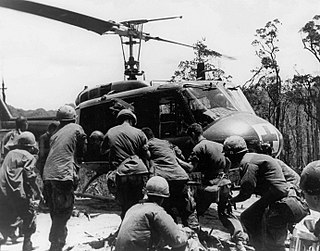 W
WOperation Apache Snow was a joint U.S. Army and Army of the Republic of Vietnam (ARVN) military operation during the Vietnam War designed to keep pressure on the People's Army of Vietnam (PAVN) units in the A Sầu Valley and prevent them from mounting any attacks on the neighboring coastal provinces.
 W
WDuring Operation Arc Light from 1965 to 1973, the United States deployed B-52F Stratofortresses from bases in the US to Guam to provide Battlefield air interdiction or BAI, including strikes at enemy bases, supply routes and behind the lines troop concentrations, as well as occasionally providing close air support (CAS) directly to ground combat operations in Vietnam. The conventional bombing campaign was supported by ground-control-radar detachments of the 1st Combat Evaluation Group (1CEVG) in Operation Combat Skyspot. Arc Light operations usually targeted enemy base camps, troops concentrations, and supply lines.
 W
WThe Battle of Binh Ba, also known as Operation Hammer, was a battle during the Vietnam War. The action occurred when Australian Army troops from the 5th Battalion, Royal Australian Regiment fought a combined force of People's Army of Vietnam (PAVN) and Viet Cong (VC), including a company from the PAVN 33rd Regiment and elements of the VC D440 Battalion, in the village of Bình Ba, 5 kilometres (3.1 mi) north of Nui Dat in Phuoc Tuy Province. The battle was unusual in Australian combat experience in South Vietnam as it involved fierce close-quarter house-to-house fighting, although the majority of enemy killed was through heavy artillery and air-bombardment. In response to PAVN/VC attempts to capture Binh Ba the Australians assaulted the village with infantry, armour and helicopter gunships, routing the VC and largely destroying the village itself. Such battles were not the norm in Phuoc Tuy, however, and the heavy losses suffered by the communists forced them to temporarily leave the province. Although the Australians did encounter PAVN/VC Main Force units in the years to come, the battle marked the end of such large-scale clashes, and ranks as one of the major Australian victories of the war.
 W
WOperation Bold Mariner was a US Marine Corps operation that took place on the Batangan Peninsula southeast of Chu Lai, lasting from 12 January to 7 February 1969.
 W
WOperation Bolling was a search and destroy and security operation conducted during the Vietnam War by the U.S. 503rd Infantry Regiment in Phú Yên Province, South Vietnam from 19 September 1967 to 31 January 1969.
 W
WOperation Commando Hunt was a covert U.S. Seventh Air Force and U.S. Navy Task Force 77 aerial interdiction campaign that took place during the Vietnam War. The operation began on 15 November 1968 and ended on 29 March 1972. The objective of the campaign was to prevent the transit of People's Army of Vietnam (PAVN) personnel and supplies on the logistical corridor known as the Ho Chi Minh Trail that ran from the southwestern Democratic Republic of Vietnam through the southeastern portion of the Kingdom of Laos and into the Republic of Vietnam.
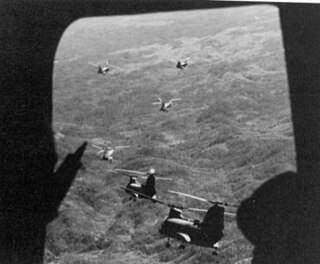 W
WOperation Dewey Canyon was the last major offensive by the 3rd Marine Division during the Vietnam War. It took place from 22 January through 18 March 1969 and involved a sweep of the People's Army of Vietnam (PAVN)–dominated A Shau and Song Đa Krông Valleys by the 9th Marine Regiment. Based on intelligence and captured documents, the PAVN unit in contact was believed to be the 9th Regiment.
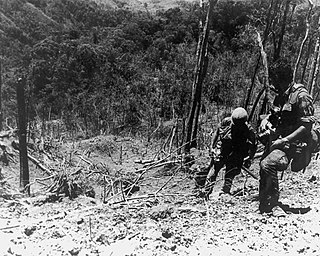 W
WThe Battle of Hamburger Hill was a battle of the Vietnam War that was fought by U.S. Army and Army of the Republic of Vietnam (ARVN) forces against People's Army of Vietnam (PAVN) forces from 10 to 20 May 1969 during Operation Apache Snow. Although the heavily fortified Hill 937 was of little strategic value, U.S. command ordered its capture by a frontal assault, only to abandon it soon thereafter. The action caused a controversy both in the American military and public.
 W
WThe Battle of Hat Dich was a series of military actions fought between an allied contingent, including the 1st Australian Task Force and the People's Army of Vietnam (PAVN) and Viet Cong (VC) during the Vietnam War. Under the codename Operation Goodwood, two battalions from 1 ATF deployed away from their base in Phuoc Tuy Province, operating against suspected PAVN/VC bases in the Hat Dich area, in western Phuoc Tuy, south-eastern Bien Hoa and south-western Long Khanh Provinces as part of a large allied sweep known as Operation Toan Thang II. The Australians and New Zealanders conducted sustained patrolling throughout the Hat Dich and extensively ambushed tracks and river systems in the Rung Sat Special Zone, occupying a series of fire support bases as operations expanded. Meanwhile, American, South Vietnamese and Thai forces also operated in direct support of the Australians as part of the division-sized action.
 W
WIn the Vietnam War, after the assassinations of Ngo Dinh Diem and John F. Kennedy in late 1963 and the Gulf of Tonkin incident in 1964 and the continuing political instability in the South, the United States made a policy commitment to begin joint warfare in South Vietnam, a period of gradual escalation and Americanization, involving the commitment of large-scale combat forces from the United States and allied countries. It was no longer assumed the Republic of Vietnam could create a desirable situation without major external assistance. This phase of the war lasted until the election of Richard Nixon, and the change of U.S. policy to Vietnamization, or giving the main combat role back to the South Vietnamese military.
 W
WOperation Menu was a covert United States Strategic Air Command (SAC) tactical bombing campaign conducted in eastern Cambodia from 18 March 1969 until 26 May 1970 as part of both the Vietnam War and the Cambodian Civil War. The targets of these attacks were sanctuaries and Base Areas of the People's Army of Vietnam and forces of the Viet Cong (VC), which utilized them for resupply, training, and resting between campaigns across the border in the Republic of Vietnam. The impact of the bombing campaign on the Khmer Rouge guerrillas, the PAVN, and Cambodian civilians in the bombed areas is disputed by historians.
 W
WOperation Sealords was a military operation that took place during the Vietnam War.
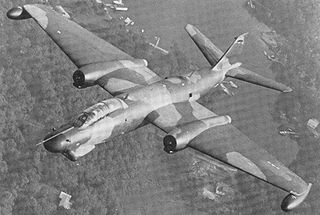 W
WOperation Shed Light was a crash development project in aerial warfare, initiated in 1966 by the United States Air Force to increase the ability to accurately strike at night or in adverse weather. During the 1960s the United States military worked hard to interdict the movement of men and materiel along the Ho Chi Minh trail. The North Vietnamese were experts in the use of weather and darkness to conceal their movement, and understanding the superiority of American air power put their skills immediately to good use. US forces seeking to impede the steady flow of supplies attempted to locate largely static targets during the day with poor results.
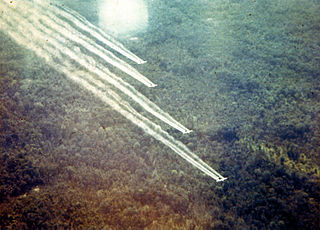 W
WOperation Ranch Hand was a U.S. military operation during the Vietnam War, lasting from 1962 until 1971. Largely inspired by the British use of 2,4,5-T and 2,4-D during the Malayan Emergency in the 1950s, it was part of the overall chemical warfare program during the war called "Operation Trail Dust". Ranch Hand involved spraying an estimated 20 million U.S. gallons (76,000 m3) of defoliants and herbicides over rural areas of South Vietnam in an attempt to deprive the Viet Cong of food and vegetation cover. Areas of Laos and Cambodia were also sprayed to a lesser extent. Nearly 20,000 sorties were flown between 1961 and 1971.
 W
WOperation Speedy Express was a controversial U.S. Army 9th U.S. Infantry Division operation of the Vietnam War conducted in the Mekong Delta provinces Kiến Hòa and Vĩnh Bình. The operation, led by Major General Julian J. Ewell, was part of US military "pacification" efforts against the Viet Cong (VC). The US military sought to interdict lines of VC communication and deny them the use of base areas. At least 5,000 to 7,000 casualties were reported to have been civilians.
 W
WOperation Taylor Common was a search and destroy operation conducted by Task Force Yankee, a task force of the 1st Marine Division supported by the Army of the Republic of Vietnam (ARVN), southwest of Hội An from 6 December 1968 to 8 March 1969.
 W
WTet 1969 refers to the attacks mounted by the People's Army of Vietnam (PAVN) and Viet Cong (VC) in February 1969 in South Vietnam during the Vietnam War, one year after the original Tet Offensive.
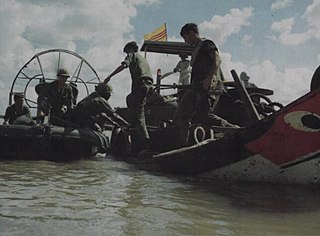 W
WOperation Toan Thang II was a U.S. Army and Army of the Republic of Vietnam (ARVN) operation conducted between 1 June 1968 and 16 February 1969 in the Vietnam War. The operation was designed to keep pressure on Vietcong (VC) and People's Army of Vietnam (PAVN) forces in III Corps.
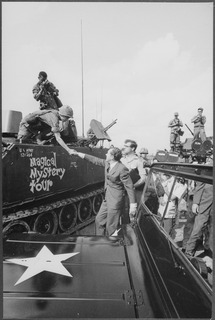 W
WVietnamization was a policy of the Richard Nixon administration to end U.S. involvement in the Vietnam War through a program to "expand, equip, and train South Vietnamese forces and assign to them an ever-increasing combat role, at the same time steadily reducing the number of U.S. combat troops". Brought on by the Viet Cong's Tet Offensive, the policy referred to U.S. combat troops specifically in the ground combat role, but did not reject combat by the U.S. Air Force, as well as the support to South Vietnam, consistent with the policies of U.S. foreign military assistance organizations. U.S. citizens' mistrust of their government that had begun after the offensive worsened with the release of news about U.S. soldiers massacring civilians at My Lai (1968), the invasion of Cambodia (1970), and the leaking of the Pentagon Papers (1971).